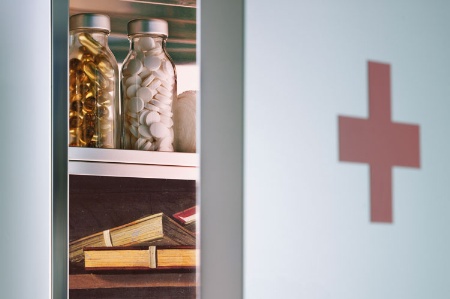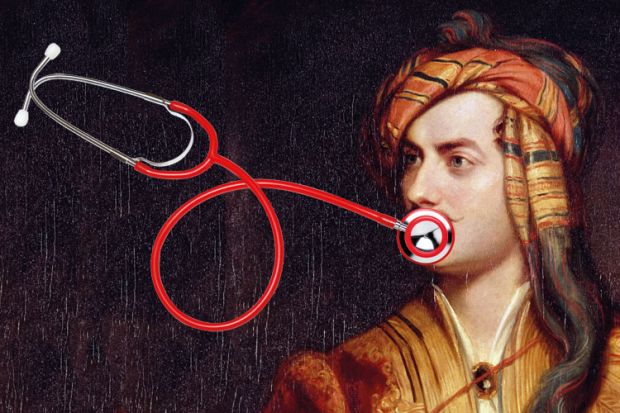Source: Getty/iStock montage
I sense quite a lot of hostility to the medical humanities among the still-dominant genes and molecules approach to medicine
The cynical account for the rise of the medical humanities – a newish interdisciplinary area that explores the social, historical and cultural dimensions of medicine – would be an economic one. At a time of retrenchment in some subjects at some universities, disciplines are under pressure to demonstrate their practical value. Recent research that claims to show that reading novels promotes empathy would be an example of literature’s utility, particularly for medical students. There’s money in medicine and not so much in the humanities.
But how new is this field or set of fields? The ancient Greek physician Hippocrates claimed that “wherever the art of Medicine is loved, there is also a love of Humanity”, suggesting both that medicine is an “art” and that there is a crucial association between medicine and the “human” dimension of the humanities.
In terms of literature, as soon as the novel rose to prominence in the 18th century a good many doctors more than dabbled in writing, often fiction. Oliver Goldsmith (1730-1774) trained as a doctor and wrote the best-selling novel The Vicar of Wakefield (1766), and Keats (1795-1821) turned to poetry in part because of the trauma he suffered by the experience of physically restraining fully conscious patients in order to perform surgery without anaesthesia. Friedrich von Schiller (1759-1805), German writer, poet, essayist, dramatist and friend of Goethe, was an army surgeon before achieving fame as a writer. The Scottish writer Tobias Smollett (1721-71) graduated from the University of Glasgow’s School of Medicine but his passion was for writing. His picaresque novels, including The Adventures of Roderick Random (1748), were immensely successful, as was his best-known work, The Expedition of Humphry Clinker (1771). By the time we get to the 19th century the number of authors combining writing and medical practice further increases. And there is no let-up in the 20th century, nor indeed the 21st.
There are also some important examples of psychiatrists drawing heavily on literature in the construction of their theories. R. D. Laing was profoundly influenced by Blake, Dostoevsky, Kafka, Beckett, Sartre and others. All this goes to show that interest in a reciprocity between medical practice and creative writing is not a new phenomenon. Nevertheless, C. P. Snow, scientist and novelist, in his famous Rede lecture of 1959, claimed that “two cultures” had developed and that the chasm between the arts and the sciences was deleterious to our civilisation.
What is new is the bringing of writing and the arts more broadly into a formal, institutional relationship with medicine. So what does mainstream medicine think about this? I asked Colin Blakemore, former chief executive of the Medical Research Council, how the medical humanities were generally regarded, and his response was: “I sense quite a lot of hostility among the still-dominant genes and molecules approach to medicine.” It’s a pity that the adjectives “hard” and “soft” have accrued certain connotations. There is a danger that they prejudice things. The medical humanities are instantly deemed to be at the “soft” end of medicine. Conventional approaches to medicine, “drugs and knives remain the dominant modes of tackling resistant medical problems, however slow progress is”, Blakemore says. Drugs, knives, genes and molecules dominate the medical world. This is the “hard” end, the end that is assumed to make the big difference. Blakemore is now, among numerous other affiliations, professor of neuroscience and philosophy at the School of Advanced Study, University of London. He is “certainly keen to encourage interaction between science and the humanities”, as his latest area of research interest testifies: the crossover points between philosophy and neuroscience.
Blakemore’s vision is shared by the Wellcome Trust, the UK’s largest non-governmental source of funds for biomedical research, which now takes the medical humanities very seriously. In 2013, the grant funding and direct charitable expenditure of the trust was more than £700 million, and the Wellcome Foundation Strategic Plan 2010-20 “supports medical humanities research”. The journal Medical Humanities is well established and Niall Boyce’s The Lancet Psychiatry has recently been launched. Boyce, himself a novelist, sees the journal in part as a point of focus for debate about the relationship between psychiatry and the humanities. These are only two of a large number of journals involved in the medical humanities.
Over the same period, courses have appeared in universities both in the UK and abroad. More than a dozen universities in the UK embrace the field and most undergraduate medical programmes offer either mandatory or optional courses in one or more humanities subjects at some point in the degree. A number of master’s courses are also coming on stream. An initiative at the University of Oxford that aims to produce the world’s largest forum for medical humanities and to provide an unparalleled resource for public and professional engagement describes the area as “a richly diverse field of scholarship which draws on disciplines in the humanities, social sciences and the arts. As well as providing insights into one of the most basic and universal of human concerns, these disciplines can inform the science and practice of medicine.” In November 2013, St Anne’s College, Oxford, in conjunction with the Wellcome Trust Centre for Human Genetics, launched its Centre for Personalised Medicine, which will embrace medicine, genomics, law, economics and ethics.

It is the stories of private lives offered up to doctors, often at times of crisis and vulnerability, that explain why so many doctors are also novelists
Reviewing its first seven issues, Medical Humanities identified various categories into which articles might be grouped. The largest included pieces on medicine and the arts, concepts of disease, illness and healing, medicine as an art and as a science, aesthetic and ethical considerations in surgery, medical classifications and diagnoses and their relationship to technology, the existential focus of clinical medicine, and the extent of chaos theory’s relevance to medicine. Next came a set of articles variously concerned with literary readings and exploration, and any lessons they may provide for clinical medicine. These included papers on short stories by Kafka and Chekhov, a play by Jules Romain, the Sherlock Holmes tales, Hamlet and depressive illness, medical syndromes in French 19th-century fiction, and television drama’s potential lessons for clinical craft. The next category comprised essentially educational enquiries into the medical humanities themselves. Can poetry, for example, help young doctors? A further set of articles was made up of historical overviews, for example of dissection, and the medical ethics of Erasmus. The last category of any size was in essence cultural studies – drawing on fine art, literature, history and philosophy to discuss a range of conditions and topics: anorexia nervosa, ageing, body image and distinguishing patients as persons.
My discipline is in essence a literary one, and I’ve been struck by a good deal of fascinating work on the importance of narrative in medicine. Physicians’ notes are in some sense biographies of their patients. Those that are unwell have to be encouraged to find a narrative and the clinician has to tease out the significant lines in their story. It is the stories of private lives offered up to doctors, often at times of crisis and vulnerability, that explain, at least in part, why so many doctors are also novelists. A combination of a move to electronic patient records and the Freedom of Information Act have militated against doctors’ patient narratives, with their nuances and insights into the complexities of human illness – and life.
I’d like to consider poetry and its less obvious role within the medical humanities. Like the novel, poetry can tell us about human experience, but it does this in its own language and not the more straightforward language of prose. It works by suggestion, but this doesn’t mean that it cannot console, teach, amuse, enlighten, mimic, disconcert and so much more. It can capture – or cause us to reconstruct – experiences and feelings that we might otherwise not be conscious of. Poetry’s use of language is at the furthest extreme from the self-help book, which is often dogmatic, insistent, reductive, bullying even. Philip Davis, in his excellent 2013 study Reading and the Reader, describes Wordsworth’s poetry not as providing “ideas”, but rather as providing places from which our own ideas – which were Wordsworth’s too, no doubt – may come into being. These “places” may be real, physical places, or imagined. This is poetry at its most magical and mysterious. Poetry offers its language up to us and if we recognise it as true, we engage; if it fails to convince us of its truth, we let it go. And it allows for an individual engagement with the poem. This explains why funeral services so often include poems, rather than extracts from novels. Each of us can ponder what the poem conjures for us, bringing something felt into clearer and thus more comforting focus. Often the poem will be one that allows us to reconsider the absolute nature of death.
But poetry can help us to make sense of more mundane experiences too, and these are sometimes equally charged with challenging emotions. Here is an example from Cecil Day Lewis’ poem Walking Away: “I can see/You walking away from me towards the school/With the pathos of a half-fledged thing set free/Into a wilderness, the gait of one/Who finds no path where the path should be.”
We have all been the “you”, embarking on school, and many of us have been the parent, the “I”, watching our child “walking away” and have experienced the pain of separation, the pain associated with knowing the vulnerability of a child starting school – and our no longer being at the child’s side to moderate life. To fully paraphrase these lines would take pages. But the “truth” I fully recognise strikes still more forcibly at the close of the poem: “How selfhood begins with a walking away,/And love is proved in the letting go.”
The pain – there are other emotions too, such as pride – that we experience as our children gain independence is inextricably bound up in our love for them. If we didn’t love them, we wouldn’t feel the pain. And we would never wish not to love them. A good deal of child development psychology is contained in these few lines. “Selfhood begins with a walking away”; in other words, to become an individual the child has to establish growing physical independence from first its mother, then its family. “Love is proved in the letting go” – as responsible parents we have to let our children distance themselves from us in order to develop into independent adults, but it sometimes hurts.
The poem can also be read as an allegory of other kinds of separation or loss that are part of life. Seeing the coffin disappear is analogous. Or hearing that a diagnosis of an illness is terminal. And our feelings of ultimate physical separation from one whom we’ve loved, the pain and rage at death, are part and parcel of that love. The “truth” of the poem extends to the psychology of bereavement too. The poem is not so much “about” separation anxiety; it enacts separation anxiety. Yet reading the poem we are no longer alone, rather we are in touch with the poet’s humanity. And the space the loss has left has been filled – by the poem. The act of recognition of truth fills the space, in some small but fundamentally important way. Faced with some of life’s most painful moments poetry can reassure us that we are not alone – other have suffered too. But a great poem also allows us to make sense of feelings that might otherwise be a searing amorphous mass somewhere deep inside us. Great poetry makes us understand the only half-understood; in that understanding comes relief, and it can feel very physical. This is art acting as a medicine.

Great poetry makes us understand the only half-understood and in that understanding comes relief and it can feel very physical
There is a growing body of research that suggests that regular exercise, long walks for example, can be more therapeutic for those suffering from depression than other therapies. At some point after 1798, feeling discouraged after a difficult time in London, Wordsworth had returned to the Lake District with his sister. In The Prelude, the mood at the outset reflects a low mood: “The sun was set, or setting when I left/Our cottage door, and evening soon brought on/A sober hour, not winning or serene,/For cool and raw the air was, and unturned.”
The poet does not describe himself as unhappy or depressed. It is the time of day and weather that imply inhospitality. But then Wordsworth manages an extraordinary feat of linguistic conjuring: “While on I walked, a comfort seemed to touch/A heart that had not been disconsolate:/Strength came where weakness was not known to be,/At least not felt…”
One of the problems in the diagnosis of depression can be the individual’s lack of awareness of low mood. In The Prelude the truth of sudden changes of mood is brilliantly suggested. Often we are not fully in touch with our melancholy, or at least not until after it has lifted, and a wonderful lightness replaces the heart that we did not know was heavy. The experience can be sharply retrospective. The poem reminds us of the undertow of mood, our only partial control of it – and that a brisk walk may be a useful medicine.
These two examples are about poetry and its relationships with psychology. My final example is somewhat different. (All three poems are discussed by Davis in Reading and the Reader.) These are lines from Philip Sidney’s Certain Sonnet 19, probably written in the 1580s: “If I could think how these my thoughts to leave,/Or thinking still my thoughts might have good end:/If rebel sense would reason’s law receive/Or reason foil’d would not in vain contend…”
This is the mind thinking about itself and the degree of control – or lack of control – that it has over its conflicting voices. The mind contemplating a mental dialogue – which is a three-way thing. How do we stop thinking thoughts that are uncomfortable (line 1)? Or accept the thoughts but steer them in a better direction (line 2)? If only the “rebel” part of the brain would submit to the “reasonable” part (line 3); or if reason has lost out to “rebel sense”, it would accept defeat and bring the mental battle to an end. Doesn’t this give us insights into the mind contemplating the workings of the mind that might even be compared to brain “imaging”? The images of the poem allude to conflict – “rebel” and “foil”, where the stability of “reason” and “law” should bring steadiness and what we call “peace of mind”. So much of life – and our responses to death – is in language.
One of the undersold features of poetry is its remarkable succinctness. The same is not always true of textbooks. And a corollary of this is that it doesn’t take much time to read a poem. But it does have to be read with a particular attention to detail, and that could be a useful training for medical students. You can’t race through a poem – as you might a textbook – looking for what you want to find. So I see the benefits of marrying poetry reading to various aspects of medicine. This is essentially what the National Association for Poetry Therapy has been doing for the past 30 years. It describes itself as “a community of healers and lovers of words”.
At the same time, there are various ways in which the humanities are enriched by disciplines within the medical sciences. Psychology can certainly play a part in both biography and biographical readings of literary texts, for example. Pharmacology can enlighten us in relation to drug-induced creative states of mind. More importantly, thinking about literature from the point of view of readers who may not be as set in their ways encourages the literary reader to read differently. Reading Dostoevsky under the umbrella of the “medical humanities” we are forcibly struck by the author’s preoccupation with God and madness, for example, a conjunction that is very real in psychiatric patients.
But I’d like to end on a lighter note and propose that humour, in literature as well as in life, has a powerful therapeutic effect too. Laughing has been demonstrated to have healing powers. Byron knew this: “Always laugh when you can, it is cheap medicine.” Humour can also allow a review of self-perspective. The American comedian George Carlin asked, “Isn’t it a bit unnerving that doctors call what they do ‘practice’?”
Register to continue
Why register?
- Registration is free and only takes a moment
- Once registered, you can read 3 articles a month
- Sign up for our newsletter
Subscribe
Or subscribe for unlimited access to:
- Unlimited access to news, views, insights & reviews
- Digital editions
- Digital access to THE’s university and college rankings analysis
Already registered or a current subscriber? Login





